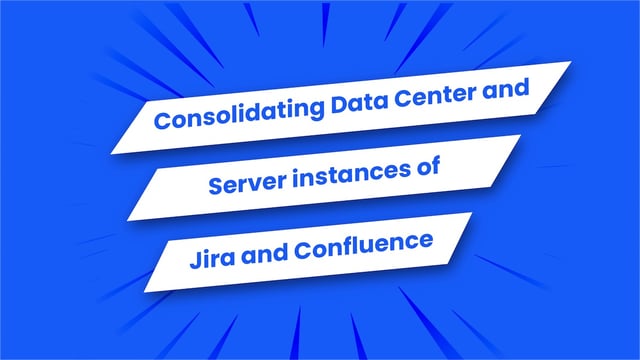Consolidating Data Center and Server instances of Jira and Confluence

What does it mean to consolidate instances?
Consolidating refers to the act of combining several instances or tools. For some, it not only improves productivity but teamwork. It can help you establish more efficient management processes and ultimately reduce costs.
Of enterprises, 99% believe that all users can operate from a single consolidated environment and within a short space of time, the vast majority end up with more than two instances of the same tool, immediately creating a federated environment.
Having a single consolidated instance of Jira has several advantages over multiple federated instances — the main one being that there’s a single platform for them to work from. Users don’t need to hunt across multiple application instances, data fragmentation, duplicated data or multiple conflicting backlogs to find work, which can occur when work is spread across multiple instances.
The chosen model doesn’t need to be single or multiple federated instances, a hybrid of both is common and counteracts the limitations of consolidation, which can be too restrictive for teams that have complex needs to work within. You can learn more about federated instances in our white paper. In this blog post, however, we will focus on consolidating instances.
Why the need to consolidate?
It is not only possible to consolidate instances of Jira but Confluence.
Not consolidating instances can impact costs due to the need to perform multiple upgrades, run redundant infrastructure and provide licensing.
After consolidating instances, siloes are broken down, and businesses often see an increase in productivity and a reduction in costs.
Atlassian states how consolidating provides IT teams with the ability to review usage where unnecessary licenses may have been purchased for team members that don’t need them. As you consolidate, auditing the number of active users could result in further savings. A way to reduce licensing costs is to have Jira Service Management with Jira Software on a single instance for tighter integration, reducing double licensing.
With greater transparency, leaders can make effective decisions, thus improving customer satisfaction levels through more granular and accelerated communication.
Next steps to consolidate your instances
There are advantages to running multiple instances and consolidating, but it ultimately comes down to what’s best for your business.
For IT teams that want to consolidate their instances, consider the following to get you moving in the right direction.
1. Plan accordingly.
Tools like Jira and Confluence are often deployed without centralised planning, leaving many businesses with a myriad of configurations, deployments and versions. Because of this, businesses are often faced with several challenges that impact the quality of services, as teams have difficulty collecting data due to silos and varied processes across departments.
2. Perform housekeeping.
It’s good practice to review your instances and clean up where you can. For example, are there projects, custom fields, spaces, or branches that aren’t actively being used? Cleaning up can make your consolidation run smoother and help with performance and cost savings in the long run.
3. Take a phased approach to consolidation.
Prioritise what needs to be moved first before moving everything at once. It’s beneficial to move larger, more commonly used spaces first to reduce friction in teams as you start to migrate to a primary instance.
4. Prepare for the unexpected.
No two businesses are the same, and that goes for migrations too. While you can’t plan for the unexpected, you can certainly prepare for it. You can do this by allowing more time in your migration timeframe.
Jira and Confluence consolidations are technically complex projects due to the need to merge large data sets and complex configurations. They are also particularly challenging from a change management perspective, as processes need to be aligned, people need to be trained, and new governance needs to be established. The long-term result is the benefit to teams already using these products and others that transition to them.
Should you need expert assistance, we can help plan your consolidation, identify risks, decide on the right path, define a clear scope for your consolidation project, and establish ROI for your business.
Thinking of migrating to Cloud? Find out more by visiting our Cloud migrations page.
Published:
Updated:


